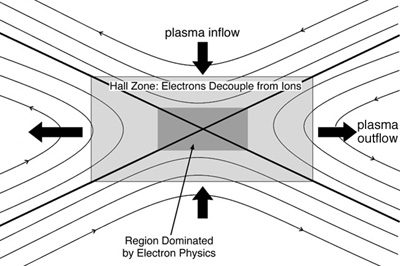MMS' Holy Grail: The Diffusion Region
In order for reconnection to occur, the magnetic field must become "unfrozen" or, said another way, the plasma must become demagnetized, and the field lines and plasma decoupled. This demagnetization -- first of the ions, then of the electrons -- occurs in a narrow boundary layer called the diffusion region.

Schematic illustrating the diffusion region, where still poorly understood processes allow reconnection to occur.
This, in broad strokes, is the picture of magnetic reconnection. But the devil -- and the physics -- are in the details, and these have proven elusive, despite some notable advances in our understanding enabled by analytical theory, computer simulations, and recent observational studies. Among the fundamental questions still to be answered are:
- How does the plasma become demagnetized in the diffusion region? In particular, what role do the electrons play in facilitating reconnection?
- What factors determine the rate at which reconnection occurs?
- What is the structure of the diffusion region?
- What conditions determine when reconnection is initiated and when it ceases?
- How does reconnection accelerate particles to high energies?
The overarching goal of the MMS mission is to unlock the secrets of the diffusion region or, in more formal language, "to understand the microphysics of reconnection by determining the kinetic processes occurring in the electron diffusion region that are responsible for collisionless reconnection."
Next: Nature's Plasma Physics Lab
|